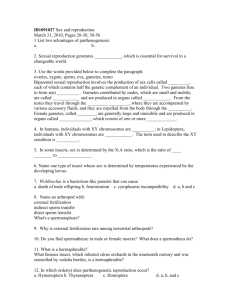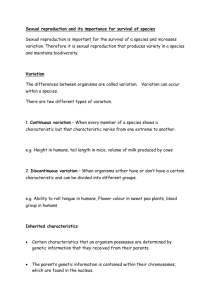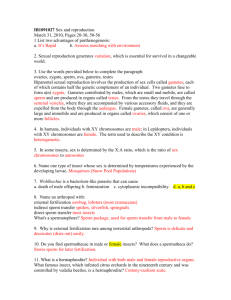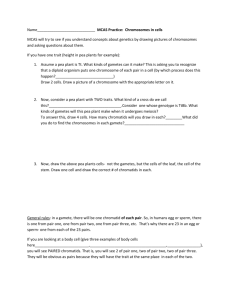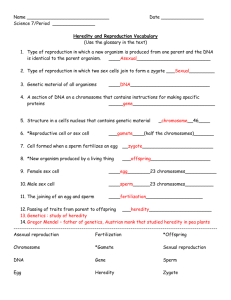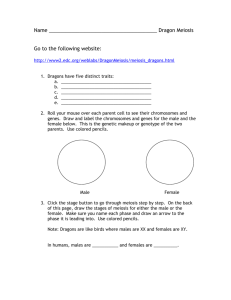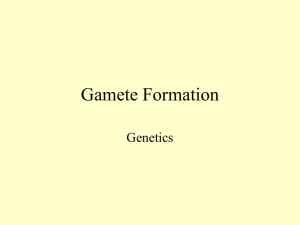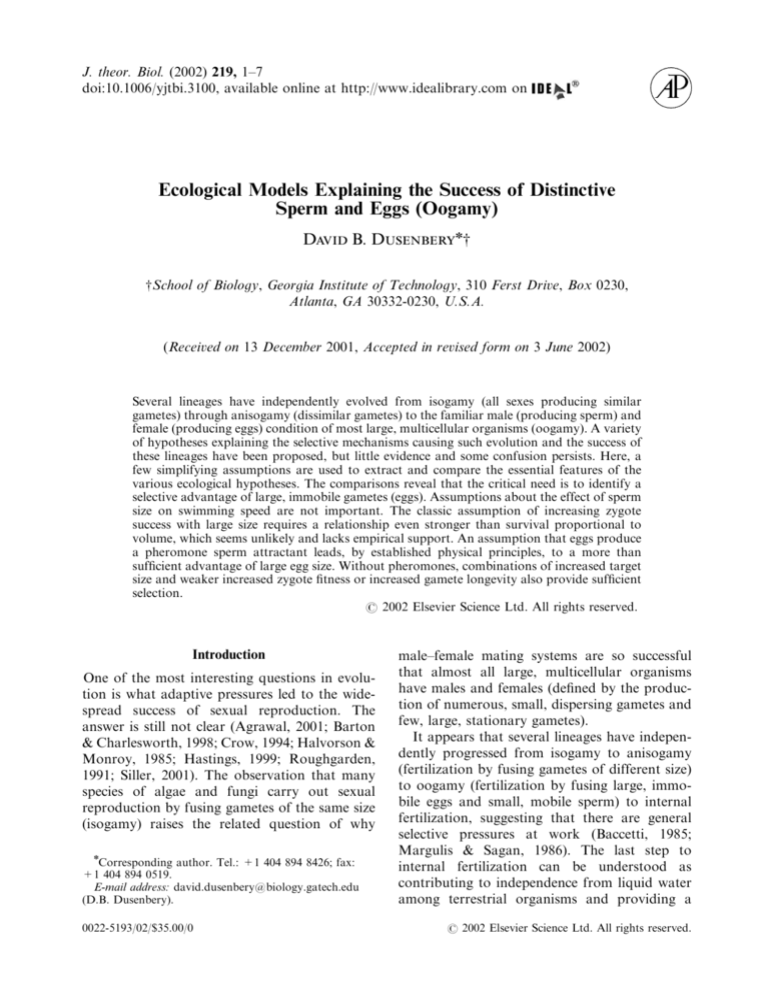
J. theor. Biol. (2002) 219, 1–7
doi:10.1006/yjtbi.3100, available online at http://www.idealibrary.com on
Ecological Models Explaining the Success of Distinctive
Sperm and Eggs (Oogamy)
David B. Dusenberynw
wSchool of Biology, Georgia Institute of Technology, 310 Ferst Drive, Box 0230,
Atlanta, GA 30332-0230, U.S.A.
(Received on 13 December 2001, Accepted in revised form on 3 June 2002)
Several lineages have independently evolved from isogamy (all sexes producing similar
gametes) through anisogamy (dissimilar gametes) to the familiar male (producing sperm) and
female (producing eggs) condition of most large, multicellular organisms (oogamy). A variety
of hypotheses explaining the selective mechanisms causing such evolution and the success of
these lineages have been proposed, but little evidence and some confusion persists. Here, a
few simplifying assumptions are used to extract and compare the essential features of the
various ecological hypotheses. The comparisons reveal that the critical need is to identify a
selective advantage of large, immobile gametes (eggs). Assumptions about the effect of sperm
size on swimming speed are not important. The classic assumption of increasing zygote
success with large size requires a relationship even stronger than survival proportional to
volume, which seems unlikely and lacks empirical support. An assumption that eggs produce
a pheromone sperm attractant leads, by established physical principles, to a more than
sufficient advantage of large egg size. Without pheromones, combinations of increased target
size and weaker increased zygote fitness or increased gamete longevity also provide sufficient
selection.
r 2002 Elsevier Science Ltd. All rights reserved.
Introduction
One of the most interesting questions in evolution is what adaptive pressures led to the widespread success of sexual reproduction. The
answer is still not clear (Agrawal, 2001; Barton
& Charlesworth, 1998; Crow, 1994; Halvorson &
Monroy, 1985; Hastings, 1999; Roughgarden,
1991; Siller, 2001). The observation that many
species of algae and fungi carry out sexual
reproduction by fusing gametes of the same size
(isogamy) raises the related question of why
n
Corresponding author. Tel.: +1 404 894 8426; fax:
+1 404 894 0519.
E-mail address: david.dusenbery@biology.gatech.edu
(D.B. Dusenbery).
0022-5193/02/$35.00/0
male–female mating systems are so successful
that almost all large, multicellular organisms
have males and females (defined by the production of numerous, small, dispersing gametes and
few, large, stationary gametes).
It appears that several lineages have independently progressed from isogamy to anisogamy
(fertilization by fusing gametes of different size)
to oogamy (fertilization by fusing large, immobile eggs and small, mobile sperm) to internal
fertilization, suggesting that there are general
selective pressures at work (Baccetti, 1985;
Margulis & Sagan, 1986). The last step to
internal fertilization can be understood as
contributing to independence from liquid water
among terrestrial organisms and providing a
r 2002 Elsevier Science Ltd. All rights reserved.
2
D. B. DUSENBERY
variety of other benefits for large, mobile
animals. But the earlier steps are more difficult
to explain.
One type of explanation that has been
explored is based on conflict between cytoplasmic elements of the two gametes. However, in
a recent review, Randerson & Hurst (2001)
conclude that this explanation is not
satisfactory.
A variety of other explanations have been
proposed over several decades (Charlesworth,
1978; Cox & Sethian, 1985; Dusenbery, 2000;
Hoekstra, 1984; Hoekstra et al., 1984; Parker
et al., 1972; Schuster & Sigmund, 1982; Scudo,
1967), but disagreement about their plausibility
and misunderstanding of their underlying assumptions continues. Most alternative explanations are ecological in the sense that they focus
on allocation of resources, selection on size,
and/or behavioral interactions between gametes.
Here, I develop an approach to analyse and
compare these models by extracting their essential size–dependent components of selection in a
common form. This allows clear comparisons of
their fundamental features and suggests several
new possible explanations.
Measure of Fitness
In quantitative models, most authors assume
that adults of both sexes have equal total
volumes ðVT Þ of cytoplasm available to form
gametes. The evolutionary choice is how many
ðnG Þ equal gametes should this volume be
divided among. The volume of each gamete
ðVG Þ is inversely related to the number of
gametes: VG ¼ VT =nG : Beyond this assumption,
authors diverge in their assumptions as to which
factors are influenced by gamete size and how
the factor depends on size. By making a few
assumptions, the several hypotheses can be
put in a common framework that facilitates
comparison.
Assume that evolutionary success depended
on survival of crises when population densities
were low. At these times, populations faced
sperm limitation, and survival depended on the
effectiveness with which appropriate gametes
came together.
Furthermore, assume (as have others) that the
important features can be captured by making
the simplifying assumptions that gametes can be
approximated as spheres and have a uniform
probability of occurrence in three-dimensional
space. Such a random distribution is most likely
to occur as a result of turbulent currents.
Although such distributions are unlikely to
occur over wide areas, they are likely at the
small spatial scales were gametes encounter each
other. Consequently, we will consider population densities, and VT is interpreted as the total
volume of each type of gamete per unit volume
of the environment.
With these assumptions, the following quantitative description can be developed. For simplicity of presentation, consider a population
spawning synchronously once per generation.
(A continuously reproducing model could have
very similar mathematical structure and conclusions.) Reproductive rate is broken down into
the product of three components: the rate at
which encounter is made between gametes of
opposite mating type (R, in number per second
per unit volume of the environment); the time
span over which gametes are effective (t, in
seconds); and the fraction of encounters that
result in a zygote that survives and develops into
a reproductive adult ð f Þ:
Assuming also that oogamy is already established, the situation is further simplified. For
immobile eggs ðEÞ and motile sperm ðSÞ; R
depends on the effective target size of the egg
(sE ¼ cross-sectional area) and swimming velocity of the sperm ðvS Þ; as well as the number
density of the two kinds of gametes (nE ; nS ). For
a spherical egg with radius rE ; sE ¼ pr2E : For a
gamete of radius rG ; VG ¼ ð4p=3Þr3G and the
density is nG ¼ VT =VG ¼ ð3=4pÞVT r3
G : Assuming that the swimming path is straight over
distances greater than the target size, many
analyses (Cox & Sethian, 1985; Dusenbery, 1992,
pp. 386–390; Gerritsen & Strickler, 1977;
Kauzmann, 1966, eqn 5–15) demonstrate that
R ¼ nE nS sE vS ¼ ðVT =VE ÞðVT =VS ÞsE vS :
Growth of a population requires that the
product Rtf exceed the density of reproductive
adults. Thus, fitness could be taken as the
product of six parameters: nS nE sE vS tf : However, it is more specific to eliminate VT ; which
SUCCESS OF OOGAMY
is assumed maximized in all cases of a given
population density, and we get the fitness
measure
w¼
Rtf
sE vS
¼
tf :
2
VE VS
VT
ð1Þ
We now see that fitness is maximized by
increasing the ratio of target cross section to
volume of the egg, the ratio of speed of
swimming to volume of the sperm, the active
time period of both gametes, and the fraction
of encounters that give rise to reproducing
adults.
To see how this fitness relates to the minimum
population size, define p as the productivity of
adults in producing gamete volume, VT ¼ pnA :
Then, in generation t þ 1; nA ðt þ 1Þ ¼ Rtf ¼
wVT2 ¼ wp2 nA ðtÞ2 : Population stability requires
nA ðt þ 1ÞXnA ðtÞ and the minimum population
limit is nA ðtÞX1=wp2 : Increasing gamete productivity has a large effect. But, for any given
productivity, it is also beneficial to increase w,
the measure of fitness used here. The main goal
of the present investigation is to identify
plausible hypotheses for why w is higher for
populations in which the two kinds of gametes
are very different in size.
Approximations of Models
Equation (1) provides a foundation for
comparing all the relevant models that have
been proposed. Although the models are diverse
and often involve complicated mathematical
expressions, each of these parameters is proportional to some power of the radius of sperm or
egg, at least in the limits of extreme dimorphism
ðrE brS Þ and oogamy ðvE ¼ 0Þ: Since the fitness
defined by eqn (1) is simply the product of six
parameters or their reciprocals, the exponents
from all the parameters can be combined and
provide a concise measure of the strength of the
influence of egg and sperm size on fitness. It is
this strength that is critical.
I will use ‘‘p’’ to symbolize proportionality.
Scudo (1967) developed a basic mathematical
model of gamete encounter probabilities, with
an emphasis on the time period for which
the gametes are functional. However, for fitness
3
he focused on the efficiency of gamete use
rather than the probability of fertilization,
which is the focus here and in most other
works. Also, we focus on what happens at the
limits of low density and can discard the
complications he used to deal with multiple
encounters.
The first model to receive much attention was
proposed in Parker et al., 1972. The authors
assumed that zygote success was proportional to
zygote volume (equal to the sum of gamete
volumes) raised to some power, x, which is a
constant determined by the environment. In the
symbols used here,
f pðVE þ VS Þx ¼ ½ð4p=3Þr3E þ ð4p=3Þr3S x
¼ ð4p=3Þx ðr3E þ r3S Þx
pðr3E þ r3S Þx :
ð2Þ
Since rE brS ; r3E þ r3S can be approximated by r3E ;
and the assumption reduces to f pr3x
E : Their
analysis indicated that if x was in the approximate range 1:8oxo2:5 anisogamy was selected
(their Figs 5–7). I used x ¼ 2 ð f pr6E Þ for the
n
example in the column labeled ‘‘Zygote ’’ in
Table 1.
Charlesworth (1978) analysed more rigorously
a similar model, concluding that x41 was
is used
sufficient (his equation 7a). So f pr43
E
in Table 1FZygotew.
Schuster & Sigmund (1982) added to the
modern literature the idea that gamete encounter
rates are important and provided calculations
assuming that non-mobile gametes encountered
each other as the result of Brownian motion.
Their equation 1 is equivalent to assuming that
1
the product sE vS ¼ ðrE þ rS Þ2 r1
E rS : In the limit,
rE brS ; this reduces to the approximation sE vS ErE r1
S ; which is used in Table 1F
Diffusion.
Hoekstra et al. (1984) analysed a model
without any dependence of zygote fitness on
size. Instead they assumed that fitness was
dominated by encounter frequency, which was
aided by pheromone attractants acting between
all gametes. The primary effect they relied on
was a reduction of the pheromone active space
with increasing speed of swimming. This effect is
4
D. B. DUSENBERY
Table 1
Comparison of anisogamy/oogamy models
n
nn
Parameter
Zygote
Zygotew
Diffusionz
Hoekstray
Search8
Pheromonez
Target
Longevity
nE or VE1
r3
E
r3
E
r3
E
r3
E
r3
E
r3
E
r3
E
r3
E
nS or VS1
r3
S
r3
S
r3
S
r3
S
r3
S
r3
S
r3
S
r3
S
sE
vS
t
f
F
F
F
r6E
F
F
F
r43
E
F
r42
E
r0E
r2
S
F
r43
E
r2E
r1
S
F
r3E
r6E
rS
F
F
r2E
F
F
r41
E
r2E
F
r2E r2S
F
Product
r3E r3
S
3
r40
E rS
4
r40
E rS
5
r40
E rS
r2E r4
S
r3E r2
S
3
r40
E rS
rE r1
S
rE r1
S
nn
Note. Subscript E refers to eggs, S to sperm. r4x is gamete radius to any exponent greater than x. The product of the six
parameters is the measure of fitness, in this situation. The relations are taken from the models in the limits rE brS ; vE ¼ 0:
n
Parker et al. (1972).
w Charlesworth (1978).
z Schuster & Sigmund (1982) did not work out how much smaller the zygote exponent could be, but this analysis indicates
that it can get down close to 2.
y Hoekstra (1984).
8 Cox & Sethian (1985).
z Dusenbery (2000).
nn
Proposed here.
well documented (Dusenbery, 1992, pp. 71–74),
but the resulting mathematics are too
complicated to solve analytically. In addition,
they ignore the serious difficulties of simultaneously releasing a pheromone yourself and
detecting that the same pheromone has been
released by another source. Given these problems, I neglect this model.
Hoekstra (1984) analysed similar models. In
this case, he assumed that fitness was proportional to swimming speed, which was in turn
inversely proportional to the cross-sectional area
ðvS pr2
S Þ: One of his models (his Section 5)
made the zygote selection on size assumption of
Parker et al. (1972), f pVZx pr3x
Z ; and his Fig. 2
indicates x must exceed 1, as Charlesworth
found. This model is summarized in Table 1F
Hoekstra.
Cox & Sethian (1985) also assumed that
encounter frequency was critical. Deriving the
relation for encounter rate among spheres
moving in straight lines, they obtained their
equation 14, which can be simplified to the more
common form for the encounter rate (e.g.
Kauzmann, 1966, eqn 5–15; Gerritsen & Strickler, 1977), assuming vS XvE :
R ¼ pnE nS ðrE þ rS Þ2 ð3v2S þ v2E Þ=3vS ;
ð3Þ
For oogamy, vE ¼ 0 and rEbrS, these assumptions give us the approximation
REpnE nS r2E vS :
ð4Þ
They further assumed that gametes are propelled
at constant thrust, independent of size. Under
the appropriate conditions (low Reynolds number) it is well established (Stokes’ law) that, at
constant thrust, speed is inversely proportional
to size ðvS pr1
S Þ: Thus, their model includes the
fundamental relation
RpnE nS r2E r1
S :
ð5Þ
With their assumption that f pr3E ; their model
has fitness
3 2 1 3
2 4
w ¼ Rtf pRf pr3
E rS rE rS rE prE rS :
ð6Þ
This relation is included in Table 1FSearch.
Dusenbery (2000) adopted a similar model but
discarded the assumption that zygote size contributed to fitness and added the assumption that
eggs produce a pheromone sperm attractant.
This assumption dramatically increased the
target size of the egg. Assuming that the
resources available for pheromone production
or propulsion are proportional to gamete
volume and that diffusion is the only mechanism
SUCCESS OF OOGAMY
of pheromone transport, a detailed model,
including recognition of the volume of cargo
(chromosomes) that a gamete must carry, was
developed. For oogamy, his equation 3 is
equivalent to
2 2
3
1 1=2
;
Rpr3
S rE ðrS þ rP Þ ðrS FrS Þ
ð7Þ
where rP is the radius of the active space of the
pheromone. With the assumption of diffusion,
the radius out to the detection threshold
concentration is proportional to the rate of
pheromone production, which is proportional
to the volume of the egg minus the volume
occupied by the genetic cargo, giving rP ¼ r3E 21:
The size scale here is the minimum
radius necessary to enclose the chromosome
volume, and rP XrE brS 41: The approximations
2
give rS þ rP ErP pr3E and r2S 2r1
S ErS ; which
lead to
3 6
3 2
w ¼ Rtf pRpr3
S rE rE rS ¼ rE rS ;
ð8Þ
which is included in Table 1FPheromone. In
this model, pheromone production and power
applied to propulsion are both proportional to
volume. At low Reynolds number, the latter
assumption results in speed directly proportional
to linear size, vS prS (Dusenbery & Snell, 1995).
Results
The fundamental relations for fitness dependence on egg and sperm size have been extracted
from each of the published models and presented
in Table 1.
For the disruptive selection on gamete size
necessary to favor oogamy over isogamy, the
fitness must have a positive exponent on egg size
and a negative exponent on sperm size, so that
fitness increases with larger eggs and smaller
sperm (over at least some size range). Since the
number of gametes ðnG Þ provides all models with
a negative three exponent for both gametes, it
alone provides strong selective pressure for small
sperm size, and assumptions about sperm swimming speed are not critical. The challenge is to
find a selective pressure that favors large egg size
sufficient to overcome the loss of numbers with
large size. This notion is consistent with the view
that the isogamy-to-oogamy transition involved
5
the growth of egg size more than the shrinkage
of sperm (Bell, 1997).
The classical solution is to assume that zygote
fitness ð f Þ increases strongly with zygote volume
ðVZ Þ: However, it is easy to see from the analysis
presented here that f must be more than
proportional to volume ðr43
E Þ; since gamete
number declines in proportion to volume. The
first analysis (Parker et al., 1972) suggested
n
f pr6E was sufficient (Table 1FZygote ), while
a subsequent (more rigorous) analysis (Charlesis sufficient
worth, 1978) indicated f pr43
E
(Table 1FZygotew). The latter constraint corresponds with the proposed requirement of a
positive exponent on egg size for the overall
fitness.
Schuster and Sigmund (1982) added a gameteencounter mechanism based on Brownian motion, without any motile gametes. From Table 1
FDiffusion, it is seen that this reduces the
required size dependence of zygote success from
greater than proportional to volume ðr43
E Þ to
Þ;
which
is
greater than proportional to area ðr42
E
a more plausible possibility.
Hoekstra (1984) adds the assumption that
to the gamete number assumptions.
vS pr2
S
Table 1FHoekstra, reveals that this assumption
accomplishes little, as it does not contribute to
selection for large eggs. And it is still necessary
to assume that zygote success is more than
proportional to volume.
Cox & Sethian (1985) emphasize the advantage of increased target size with larger eggs.
When this is combined with the assumption that
zygote success is proportional to volume, the
required disruptive selection occurs (Table 1F
Search).
More recently, Dusenbery (2000) proposed a
detailed physical model based on the assumption
that eggs produce a pheromone sperm attractant. This provides a mechanism to dramatically
increase their target size. Assuming diffusion of
pheromone, the radius of the pheromone active
space is proportional to the rate of pheromone
production, and this radius is squared to get the
target size. Assuming the resources available
to produce pheromone are proportional to egg
volume ðr3E Þ; target area varies as the sixth power
of egg radius (square of volume), and this
provides a powerful selective force for large
6
D. B. DUSENBERY
eggs. The results in Table 1FPheromone, also
indicate that the required selection would still
occur if the assumption were relaxed to pheromone production proportional to egg surface
area ðr2E Þ: This model provides the required
selective force without any assumption that
zygote success depends on size.
Discussion
These simplifying assumptions allow essential
features of the diverse models to be extracted
and compared, permitting identification of the
critical differences between existing models and
identification of other possible hypotheses.
Although it is plausible that zygote fitness
would increase with size, there is little data
supporting this assumption (Madsen & Waller,
1983; Randerson & Hurst, 2001), and it is
doubtful that the relation is stronger than
proportional to volume ðwpr43
Z Þ as required if
this is the only selective force at work. Proportional to area ðwpr2Z Þ or linear size ðwprZ Þ
would be increasingly more plausible. The
required relation is reduced in models also
assuming that larger eggs represent a larger
target for sperm (Table 1FDiffusion, FSearch,
and FTarget models). This makes the models
more plausible but still retains the ad hoc
assumption that larger zygotes are more fit.
Assumptions about sperm swimming speed
have received more attention than deserved.
From the analysis presented here, it is clear that
no assumption about sperm swimming speed can
provide selection for large eggs. Contrary claims
(Hoekstra, 1984, 1987) are based on unreasonably throwing out the volume/number trade-off
for gametes. It has been argued (Dusenbery,
2000; Dusenbery & Snell, 1995) that the best
assumption for the relation between swimming
speed and sperm size is direct proportionality,
but this assumption has been criticized (Randerson & Hurst, 2001). In any case, it is clear that
this assumption is not necessary in the pheromone model (Table 1FPheromone; Dusenbery, 2000). In fact, Dusenbery’s assumption
makes selection for dimorphism more difficult.
Any of the other assumptions used for vS in any
of these models increases the strength of selection for dimorphism.
The analysis presented here makes it easy to
see alternative models that have not previously
been proposed. A straightforward prediction of
search theory leads to the expectation that target
size is proportional to egg cross-sectional area
ðsE pr2E Þ (Cox & Sethian, 1985; Dusenbery,
1992, pp. 386–390). This assumption provides
the necessary selection, if it is combined with an
assumption that zygote success is more than
proportional to linear size ð f pr41
E Þ (Table 1F
Target), which is much more plausible than
proportional to volume ð f pr43
E Þ:
Alternatively, consider a population spawning
continuously, producing C volumes of gametes
per second. If gametes of mating type G are
active for tG seconds, then we have nG ¼ CtG =VG
in comparison to the previous relation nG ¼
VT =VG for synchronous populations. If we now
assume that the active time period of a gamete is
proportional to its surface area ðtG pr2G Þ then
nG pr1
G : As shown in Table 1FLongevity,
when combined with the standard target-size
assumption, this assumption of gamete longevity
is sufficient to provide the required disruptive
selection, and longevity proportional to volume
would work even better.
At present, the most plausible selective force
seems to be provided by the pheromone model
(with any of several possible speed assumptions),
since the eggs of many species are known to
release sperm attractants (Hoekstra, 1987; Hoekstra et al., 1984). Also it provides the strongest
selection for larger eggs, and the excess selective
is needed) can accompressure (r3E where r40
E
modate weaker relationships than assumed in
the calculation. For zygote size selection to be as
strong, fitness must be proportional to the
square of zygote volume (sixth power of radius),
which seems extremely unlikely. Most of these
mechanisms are not mutually exclusive, and size
benefits of gamete longevity, and zygote success
could contribute to selection, although unlikely
to be sufficient on their own.
It should be pointed out that these models are
not all at the same level of abstraction. The
assumption of selection on zygote size has no
mechanistic theory identifying a selective agent
or empirical support; the emphasis of the
authors was on population genetics. The proposed selection on gamete longevity has similar
SUCCESS OF OOGAMY
status. In contrast, most of the other models
provide mechanistic theories with specified
selective agents; the emphasis is on identifying
the selective forces at workFoften well-established constraints of physics. Future work
should aim to combine the two approaches to
provide a mechanistically plausible selective
force with population genetics models.
It is useful to note that there are two distinct
questions regarding the evolution of oogamy.
One is: How did oogamy evolve in the first
place? This question is addressed more by
population genetics approaches, but the present
analysis should help identify selective forces.
Whatever the mechanism, the evidence indicates
that oogamy evolved independently in several
lineages (Baccetti, 1985; Margulis & Sagan,
1986). The second question is: Why have
lineages with oogamy been so successful in
producing large organisms? The analysis presented here bares more clearly on this question,
especially if it is assumed that longevity of the
lineage (ability to survive population crashes)
was a critical factor necessary to provide the
time to evolve multicellularity and the physiological systems (circulation, gas exchange, etc.)
necessary for large body size.
I thank an anonymous reviewer for thoughtful comments and suggestions for improving the
manuscript.
REFERENCES
Agrawal, A. F. (2001). Sexual selection and the maintenance of sexual reproduction. Nature 411, 692–695.
Baccetti, B. (1985). Evolution of the sperm cell. In:
Biology of Fertilization (Metz, C. B. & Monroy, A., eds),
Vol. 2, pp. 3–58. Orlando: Academic Press.
Barton, N. H. & Charlesworth, B. (1998). Why sex and
recombination. Science 281, 1986–1990.
Bell, G. (1997). The evolution of the life cycle of brown
seaweeds. Biol. J. Linnean Soc. 60, 21–38.
7
Charlesworth, B. (1978). The population genetics of
anisogamy. J. theor. Biol. 73, 347–357.
Cox, P. A. & Sethian, J. A. (1985). Gamete motion,
search, and the evolution of anisogamy, oogamy, and
chemotaxis. Am. Nat. 125, 74–101.
Crow, J. F. (1994). Advantages of sexual reproduction.
Dev. Genet. 15, 205–213.
Dusenbery, D. B. (1992). Sensory Ecology. New York:
W. H. Freeman and Company.
Dusenbery, D. B. (2000). Selection for high gamete
encounter rates explains the success of male and female
mating types. J. theor. Biol. 202, 1–10.
Dusenbery, D. B. & Snell, T. W. (1995). A critical body
size for use of pheromones in mate location. J. Chem.
Ecol. 21, 427–438.
Gerritsen, J. & Strickler, J. R. (1977). Encounter
probabilities and community structure in zooplankton: a
mathematical model. J. Fish. Res. Board Can. 34, 73–82.
Halvorson, H. O. & Monroy, A. (1985). The Origin and
Evolution of Sex. New York: Alan R. Liss.
Hastings, I. M. (1999). The costs of sex due to deleterious
intracellular parasites. J. Evol. Biol. 12, 177–183.
Hoekstra, R. F. (1984). Evolution of gamete motility
differences II. Interaction with the evolution of anisogamy. J. theor. Biol. 107, 71–83.
Hoekstra, R. F. (1987). The evolution of sexes. In: The
Evolution of Sex and its Consequences (Stearns, S. C., ed.),
pp. 59–91. Basel: Birkhäuser Verlag.
Hoekstra, R. F., Janz, R. F. & Schilstra, A. J. (1984).
Evolution of gamete motility differences I. Relation
between swimming speed and pheromonal attraction.
J. theor. Biol. 107, 57–70.
Kauzmann, W. (1966). Kinetic Theory of Gases.
New York: W. A. Benjamin, Inc.
Madsen, J. D. & Waller, D. M. (1983). A note on the
evolution of gamete dimorphism in algae. Am. Nat. 121,
443–447.
Margulis, L. & Sagan, D. (1986). Origins of Sex.
New Haven, CT: Yale University Press.
Parker, G. A., Baker, R. R. & Smith, V. G. F. (1972).
The origin and evolution of gamete dimorphism and the
male–female phenomenon. J. theor. Biol. 36, 529–553.
Randerson, J. P. & Hurst, L. D. (2001). The uncertain
evolution of the sexes. Trends Ecol. Evol. 16, 571–579.
Roughgarden, J. (1991). The evolution of sex. Am. Nat.
138, 934–935.
Schuster, P. & Sigmund, K. (1982). A note on the
evolution of sexual dimorphism. J. theor. Biol. 94,
107–110.
Sudo, F. M. (1967). The adaptive value of sexual
dimorphism: I, anisogamy. Evolution 21, 285–291.
Siller, S. (2001). Sexual selection and the maintenance of
sex. Nature 411, 689–692.


